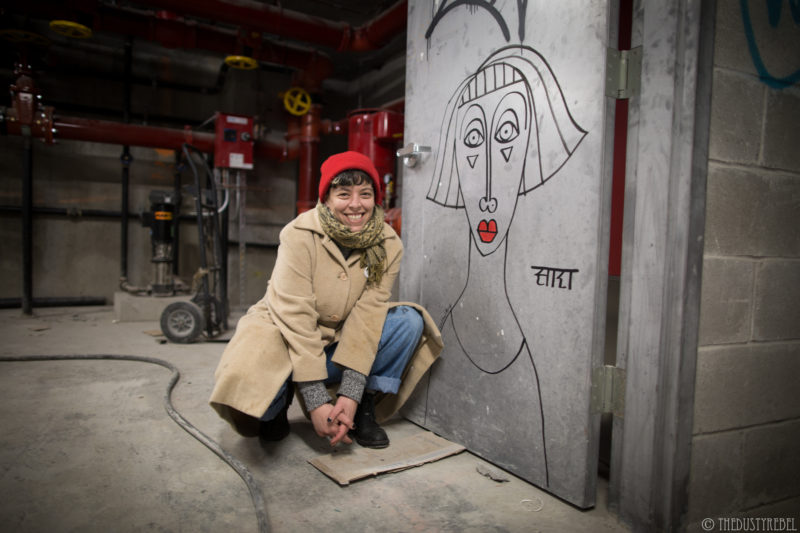If you spend much time in the Park Slope and Prospect Heights neighborhoods of Brooklyn, chances are you’ll spot a distinctive woman’s face again and again. Sara Erenthal’s public art first caught my eye when I saw her mural of three women on Union Street across from the Park Slope Food Coop. Then the same face appeared in large scale on a curbside mattress, on the walls of various local establishments, on an abandoned piece of IKEA furniture, and then on a tote bag—which is how I met Sara at Café Regular over coffee.
Sara’s ubiquitous women promote visibility in unexpected places. Turning up on the street, on storefronts, they are impossible to miss with their bright red lips and striking bold lines. Unmistakably feminine, they are more arresting than they are coy; however, they are not without an element of whimsy. This signature image has made Erenthal a Brooklyn artistic celebrity of sorts, building on a long-standing New York City tradition of street art. As a member of a tradition that typically brings to mind men such as Jean-Michel Basquiat and Keith Haring, Erenthal stands out not only as a woman, but also one who carved her way out of her Orthodox Jewish community in order to live freely as an artist.
Her work is gaining momentum beyond the street. “Moving On,” her recent one-woman show of paintings at the Five Myles gallery in Crown Heights, Brooklyn just closed, but her work has been spotted all over Manhattan as part of the artist series Resistance is Female. Capturing the spirit of the Guerrilla Girls of the 1980s, this collective is taking over advertisements, replacing them with art that demands that the personal is political.
While Erenthal remains passionately committed to street art, her studio art has provided her with an opportunity to expand her themes while also exploring new techniques. As a self-taught artist, she works with an urgency that belies a desire to make up for lost time. During a time in which funding for the arts are threatened, one need only look to the street to see that art will flourish under any condition. Through it, we find the slant of optimism. Erenthal’s watchful women hold their vigil as her work evolves and grows.
—Lauren LeBlanc for Guernica
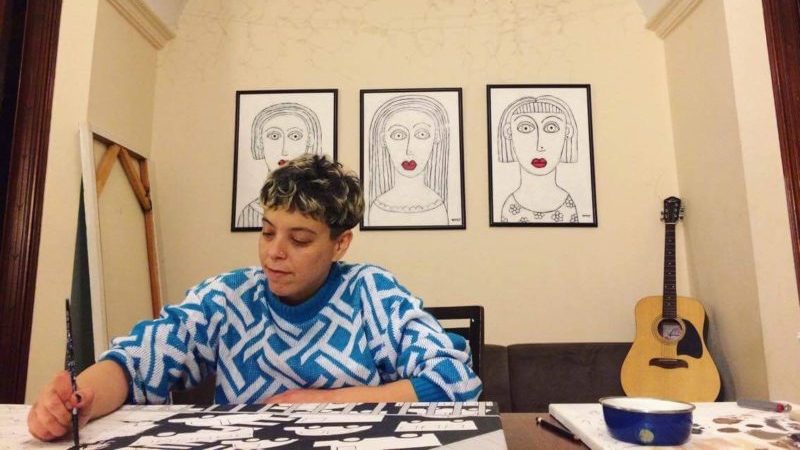
Guernica: Growing up in an ultra-orthodox Jewish family, you were incredibly sheltered. Could you talk about your first experiences with art? Was it in a museum, a classroom, books, or in public?
Sara Erenthal: I come from a creative family, and my mother would draw and paint sometimes. The only other art that I was exposed to outside of my home was traditional oil paintings of landscapes or rabbis. We never went to museums or galleries. We had an art teacher in grade school who made us draw fruit, but I wasn’t interested in drawing fruit. We did not have any access to any secular books. We read some Jewish children’s books that had illustrations, but nothing that really spoke to me. I also remember seeing graffiti around New York City, but I didn’t understand it.
My first experience with art that made me feel something was after I left home. A friend who helped me escape my community was making African masks, and I really loved them.
When I was seventeen years old, my family moved back to Israel. Soon after they made an arrangement for me to meet a man they wanted me to marry. I did not want to meet this man, nor did I want to get married at that time. I tried to say no, but they did not accept that, so I had no choice but to run away from home the night before I was supposed to meet him. Some distant, slightly more modern Orthodox relatives helped me at first, but I realized soon enough that I did not want to stay religious at all. Because I had always doubted religion and stopped believing in God at a young age, I decided my best escape from religion would be to join the Israeli Army.
When I went to the recruitment office, still dressed as an ultra-Orthodox girl, my translator (I did not speak Hebrew) looked me up and down and asked why a religious girl like me would join the military. I told him I was not religious, but dressed like that because I wouldn’t have anywhere to stay if I changed my clothes. He told me he wanted to help me and took me into his home that night. He was an artist. The next day he took me to his parents’ home, where I had my first real connection to modern art. Some pieces were from their collection, and some were African masks that his father had made. His parents hosted me until they could find me a better place to live in a kibbutz. They are amazing people and we’re still in touch.
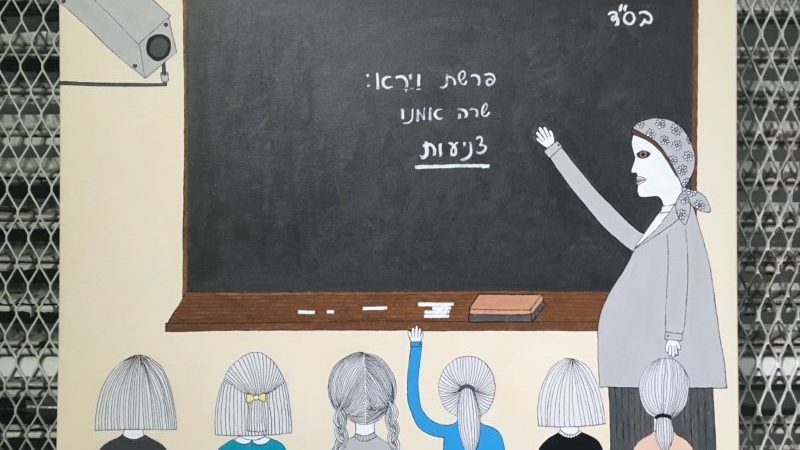
Guernica: When and how did art become a part of your life after you ran away from home to escape an arranged marriage? Was art an escape for you or was it a means of processing your experiences?
Sara Erenthal: Art was always a big part of my heart. I doodled a lot as a kid, but I didn’t think I was any good at it because I did not like drawing in a traditional style, which I thought was the only thing that is real art. I also didn’t know any professional artists while growing up, especially not female artists. I did not know art could be a career, much less how to make a career out of art. For ten years after leaving my community, I found myself drawing mostly when I was feeling strong emotions, like when I was in love or heartbroken.
During the first ten years after completing the army and returning to New York, I worked a wide variety of administrative jobs, as well as some nanny stints here and there. When I got laid off from my last office job as an assistant merchandiser in a diamond jewelry company, I knew I needed to do something more creative. I gave up my apartment, put all my belongings in storage, and went to visit friends in Israel. I was planning on returning to New York City a month later, but while in Israel, I met up with my old friend, the one who had helped me escape religion, and we spoke about where I was with my life. He suggested that I should travel in India to find my passion. I bought a ticket and was in India two weeks later. This was 2010.
Art became a major part of my life. When I found myself backpacking in India where I had a lot of free time on my hands. I started drawing every day, and that’s when my skills began to develop. Discovering a passion for creating art helped me work through a lot of things from my past. Art has become my only way of coping. I cannot imagine my life without creating art.
Guernica: You share your work through Instagram and tag your public work with your Instagram handle, @saraerenthalart. Could you talk about the ways in which Instagram community serves as a forum for critique and inspiration?
Sara Erenthal: I use my Instagram like a blog. I share a lot of moments of my life, not just my art. I started leaving my Instagram handle on my public pieces because I was curious to know what kind of response people would have to my work. I was worried that they might not like it. But most people did. I then continued leaving my Instagram handle because I wanted people to have a way of finding out more about me if they wanted to. I don’t follow a lot of people on Instagram. I mostly follow people I know in real life and some other artists whose work speak to me.
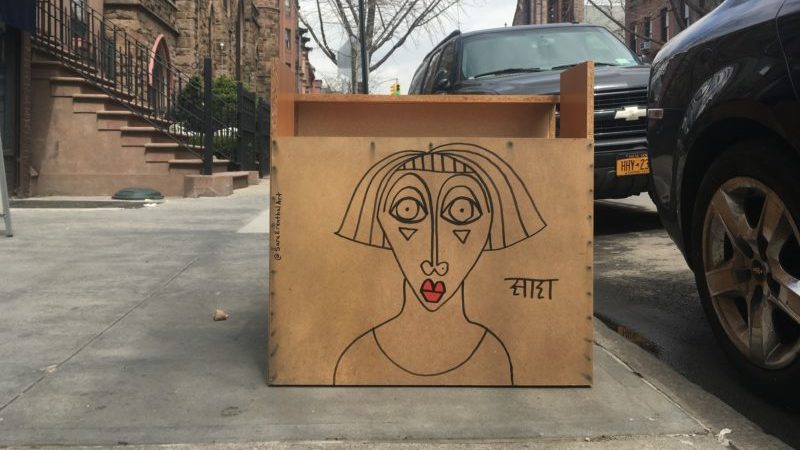
Guernica: Could you talk about the differences between the art you create for private display and your public art? Is there a distinction for you as an artist? How do these different experiences as both a public and private artist inform one another?
Sara Erenthal: My work all comes from the same place in my heart. I’d say the work that I do on the street is an extension and a more simplified version of the work that I do in the studio. Both are personal work and I feel attached to both. The only real difference I see is that I have no control over what happens to the work I create on the street. My studio art is protected by both me and my collectors, and will probably last longer.
Guernica: How important is it for you to see art on the street?
Sara Erenthal: Public art brings light, hope and people together. It not only beautifies a neighborhood, but also reaches and inspires all kinds of people who wouldn’t necessarily walk into a gallery or a museum, and that’s really important to me.
I can’t name any particular artist whose work I’ve seen on the street. I remember seeing graffiti on subways and near my old neighborhood Borough Park when I was growing up, but I didn’t understand it. I like to imagine that I saw Keith Haring and Basquiat’s work on the streets when I was very young, and maybe I did, but my childhood memories are very vague. I was only introduced to Keith Haring and Basquiat’s work a bit later once I started pursuing art. It all felt so familiar and inspiring. It made me wish even more that I’d grown up in a normal world and that I’d known what I was seeing as a child during a very special time in New York City.
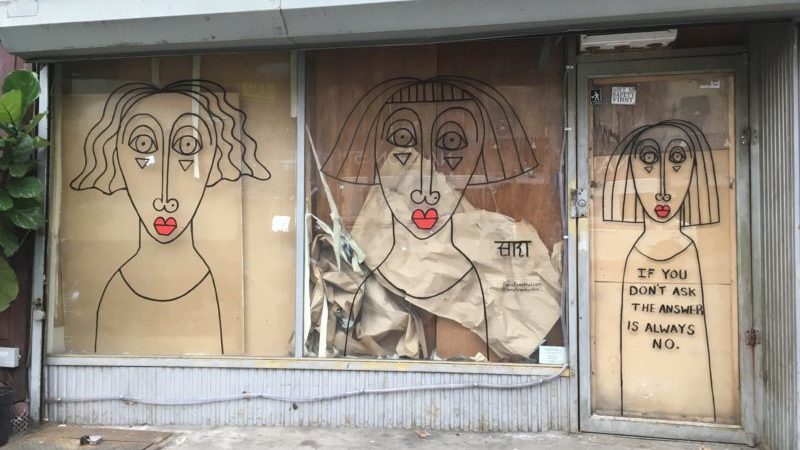
Guernica: Although you recently held an exhibition at Five Myles in Crown Heights, your work is highly recognizable throughout the Park Slope, Prospect Heights, and Crown Heights neighborhoods. Readers recognize your work in murals and find your art on abandoned furniture and mattresses. When did you begin to paint and draw in public spaces?
Sara Erenthal: I’ve always appreciated public art. I’ve also always loved writing on walls. There’s something about it that feels like a release. When I first started pursuing art, I would leave little messages and faces around the city illegally. But I realized that I did not want to risk being arrested, especially since I didn’t have a family who would bail me out.
I stopped doing that, and focused only on my studio work. I would often bring home potential canvases, like wood and pieces of furniture, from the street to paint on because art supplies are expensive. One day in Chinatown, I noticed this beautiful discarded window. I wanted to take it home, but it was too heavy so I spontaneously decided to draw on it with markers and taped my business card to it. A guy who worked at a shop across the street saw me working and he came running over and asked for my Instagram. He messaged me the next day saying that a happy-looking couple had taken my piece. That really made me happy, and since then I’ve seen discarded items on the street from a whole new perspective. Even pieces that I wouldn’t take home became blank canvases to me.
I started drawing on televisions and mattresses and other old things I noticed laying around for a long time. Over time, I realized that people started taking home my drawings on pieces of furniture, which motivated me to do even more of them because I was saving trash from ending up in some landfill. Since then, I’ve also been commissioned to paint murals around Brooklyn, and I’ve really enjoyed sharing my work with the public.
